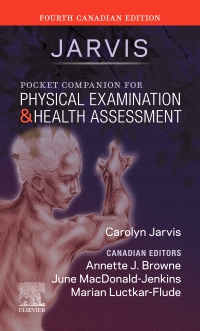
Pocket Companion for Physical Examination and Health Assessment - Elsevier eBook on VitalSource, 4th Edition
Elsevier eBook on VitalSource

The practical nursing handbook students can use in the clinical setting! Pocket Companion for Physical Examination and Health Assessment, 4th Canadian Edition makes it fast and easy to look up essential assessment skills and techniques. This portable clinical guide helps students conduct more effective exams by referring to summaries of examination steps, normal versus abnormal findings, lifespan and multicultural considerations, and over 200 full-colour photos and illustrations. With added content on the electronic health record, charting, paediatrics, pregnant and aging adult patients, and reporting, this handbook is a perfect clinical tool for both beginners who are learning assessment skills and practitioners who need a portable reference!
-
- NEW! Updated content throughout corresponds to the 4th Canadian edition of the textbook and incorporates the latest research and evidence-informed practice
- Developmental Considerations sections highlight content specific to infants, children, adolescents, pregnant individuals, and older adults
- Cultural and Social Considerations sections reflect the cultural diversity of Canada’s population
- Two-column format for examination content makes it easier to access, learn, and understand key physical examination skills and findings
- Content on the electronic health record, charting, and reporting provides examples of how to document assessment findings
- More than 200 full-colour illustrations demonstrate examination skills, underlying anatomy and physiology, and normal and abnormal findings to provide a complete picture for physical examination
- Normal and abnormal examination photos offer a fresh perspective on key system examinations, along with cultural diversity and developmental variations
- Abnormal findings tables help students recognize, sort, and describe key abnormal findings
- Colour-coded bars visually segment each body system chapter into major sections — anatomy, subjective data, objective data, and abnormal findings — to make content easier to find
- Summary Checklists offer reviews of key examination steps
-
- NEW! Updated content throughout corresponds to the 4th Canadian edition of the textbook and incorporates the latest research and evidence-informed practice
-
1. The Interview and the Complete Health History
2. Mental Health Assessment
3. Assessment Techniques and the Clinical Setting
4. General Survey, Measurement, Vital Signs, and Pain Assessment
5. Skin, Hair, and Nails
6. Head, Face, and Neck, Including Regional Lymphatic System
7. Eyes
8. Ears
9. Nose, Mouth, and Throat
10. Breasts and Regional Lymphatic System
11. Thorax and Lungs
12. Heart and Neck Vessels
13. Peripheral Vascular System and Lymphatic System
14. The Abdomen
15. Musculo-skeletal System
16. Neurological System
17. Male Genitourinary System
18. Female Genitourinary System
19. Anus, Rectum, and Prostate
20. The Complete Health Assessment: Putting It All Together
21. Bedside Assessment and Reporting



 as described in our
as described in our 